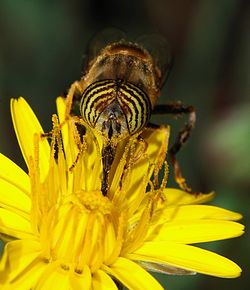
Pollinator
Background to the schools Wikipedia
Arranging a Wikipedia selection for schools in the developing world without internet was an initiative by SOS Children. Click here to find out about child sponsorship.
A pollinator is the biotic agent ( vector) that moves pollen from the male anthers of a flower to the female stigma of a flower to accomplish fertilization or syngamy of the female gamete in the ovule of the flower by the male gamete from the pollen grain. Though the terms are sometimes confused, a pollinator is different from a pollenizer, which is a plant that is a source of pollen for the pollination process.
Types of pollinators
The most recognized pollinators are the various species of bees, which are plainly adapted to pollination. Bees typically are fuzzy and carry an electrostatic charge. Both features help pollen grains adhere to their bodies, but they also have specialized pollen-carrying structures; in most bees, this takes the form of a structure known as the scopa, which is on the hind legs of most bees, and/or the lower abdomen (e.g., of megachilid bees), made up of thick, plumose setae. Honey bees, bumblebees, and their relatives do not have a scopa, but the hind leg is modified into a structure called the corbicula (also known as the " pollen basket"). Most bees gather nectar, a concentrated energy source, and pollen, which is high protein food, to nurture their young, and inadvertently transfer some among the flowers as they are working. Eusocial bees such as honey bees need an abundant and steady source of pollen to multiply.
Euglossine bees pollinate orchids, but these are male bees collecting floral scents rather than females gathering nectar or pollen. Female orchid bees act as pollinators, but of flowers other than orchids.
Lepidoptera ( butterflies and moths) also pollinate to a small degree. They are not major pollinators of our food crops, but various moths are important for some wildflowers, or other commercial crops such as tobacco.
Many other insects accomplish pollination. Wasps (esp. Sphecidae and Vespidae), bombyliid flies and syrphid flies are important pollinators of some plants. Beetles, midges, and even thrips or ants can sometimes pollinate flowers. Green bottle or carrion flies are important for some flowers, usually ones that exude a fetid odour. Some male Bactrocera fruit flies are exclusive pollinators of some wild Bulbophyllum orchids that have a specific chemical attractant present in their floral fragrance. Some Diptera (flies) may be the main pollinators in higher elevations of mountains whereas Bombus species are the only pollinators among Apoidea in alpine regions at timberline and beyond. Other insect orders are rarely pollinators, and then typically only accidentally (e.g., Hemiptera such as Anthocoridae, Miridae)
Bats are important pollinators of some tropical flowers. Birds, particularly hummingbirds, honeyeaters and sunbirds also accomplish much pollination, especially of deep-throated flowers. Other vertebrates, such as monkeys, lemurs, possums, rodents and lizards have been recorded pollinating some plants.
Plants fall into pollination syndromes that reflect the type of pollinator being attracted. These are characteristics such as: the size, the depth of the corolla, the colour (including patterns called nectar guides that are visible only in ultraviolet light), the scent, amount of nectar, composition of nectar, etc. For example, birds visit red flowers with long narrow tubes and lots of nectar, but are not as strongly attracted to wide flowers with little nectar and copious pollen, which are more attractive to beetles. When these characteristics are experimentally modified (altering colour, size, orientation), pollinator visitation may decline,.
Humans can be pollinators, as many gardeners have discovered that they must hand pollinate garden vegetables, whether because of pollinator decline (as has been occurring in parts of the U.S. since the mid-20th century) or simply to keep a strain genetically pure. This can involve using a small brush or cotton swab to move pollen, or to simply tap or shake tomato blossoms to release the pollen for the self pollinating flowers. Tomato blossoms are self fertile, but (with the exception of potato-leaf varieties) have the pollen inside the anther, and the flower requires shaking to release the pollen through pores. This can be done by wind, by humans, or by a sonicating bee (one that vibrates its wing muscles while perched on the flower), such as a bumblebee. Sonicating bees are extremely efficient pollinators of tomatoes, and colonies of bumblebees are quickly replacing humans as the primary pollinators for greenhouse tomatoes.
Millions of hives of honey bees are contracted out as pollinators by beekeepers, and honey bees are by far the most important commercial pollinating agents, but many other kinds of pollinators, from bluebottle flies, to bumblebees, orchard mason bees, and leaf cutter bees are cultured and sold for managed pollination.


